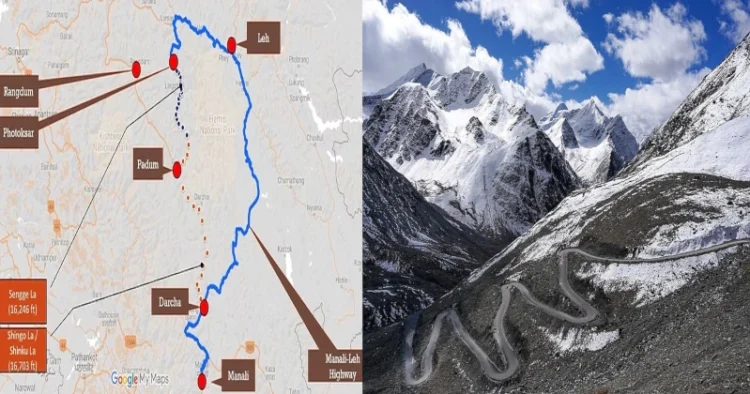The Border Roads Organisation (BRO) has an interesting philosophy: We will find a way. Or we will make a way. On Holi, March 25, it achieved a rare feat, acting on the second part of this philosophy, in making a way where none ever existed. This was something for which its personnel had worked day and night for years together. It was to connect the strategic Nimmu-Padam-Darcha (NPD) road, which will act as the third axis to Ladakh.
Like most connectivity projects in high mountains and challenging terrains, work was done at both ends. On the NPD road, too, work was going apace on the Kargil side in Ladakh and proceeding from the Darcha side of Himachal Pradesh. On Holi, the two sides removed all obstacles and shook hands! On the official X (formerly Twitter), this moment was called the “Handshake Moment.” This signalled that the road was through, and what seemed like a dream once was now coming to fruition.
Incidentally, the 298-km-long road will provide all-weather connectivity to Ladakh. Shinkun La Tunnel on this road remains a work in progress, and once completed, it will provide seamless connectivity to Leh. Of course, it will provide better connectivity to Kargil’s Zanskar, one of Ladakh’s most backward areas.
That may all change in a couple of years as this route, shorter than the other two, can attract maximum traffic. Presently, Ladakh is connected to mainland India via Manali-Leh and the Srinagar-Kargil-Leh road. The new Nimmu-Padam-Darcha road is likely to be fully functional by late 2025.
Padum is one of the farthest areas of Zanskar tehsil of Kargil district in Ladakh. By road, it usually takes at least two days to cover the distance from Padum to Leh, 450 km away, via Kargil, the existing road. Once the new road is operational, the Padum-Leh road distance will be around 200 km. People from Padum will also be able to travel to the Lahaul-Spiti area with ease, and it will become a one-day journey.
Presently, Padum is perhaps most widely known for serving as the last town on the way to the famous Chadar Trek on the frozen Zanskar River. This trek is undertaken by avid adventure sports enthusiasts during the peak of winter nowadays. The new Nimmu-Padum-Darcha road travels a considerable distance along this river.
One of the basic reasons for improving connectivity was the twin perceived threats of Pakistan and China in remote Ladakh areas. The construction of the Zojila tunnel (ongoing) on the Srinagar-Kargil road, the Atal Tunnel on the Manali-Leh road, and Shinku La (also called Shingu La) on the Nimmu-Padum-Darcha road are all post-1999 Kargil conflict developments.
There was not much progress earlier on connectivity projects, but in the last ten years, things have changed drastically.
The Galwan clashes between Indian troops and those of the People’s Liberation Army (PLA) of China in June 2020 gave an added impetus to these projects.
Many roads and infrastructure projects in remote Ladakh areas were recommended by a security committee set up years after the Kargil war. These recommendations, though strategically of great importance, were not given due weightage initially. But things are changing, or have changed, in many places.
In fact, over 150 roads of over 1,300 km have come up in remote parts of Ladakh, connecting communities to nearby areas for the first time. Many of these projects were truly unique, with most labour drawn from Jharkhand and Chhatisgarh, Army officers from all over the country and the local Ladakhis pitching in. A truly magnificent effort, often in sub-zero temperatures amid continuous snowfall! Not to mention, all the surroundings were enveloped in deep white snow and frozen! Frozen literally as also in time but until the men of BRO arrived!
BRO connected the strategic Nimmu- Padam -Darcha (NPD Road), the third axis to Ladakh. On the auspicious day of Holi on March 25 2024, when the country was celebrating the festival of colours, the brave personnel of BRO connected the strategic road that will provide the shortest and all-weather axis to Ladakh. The road, with the Shinkun La tunnel, will provide seamless movement to Leh. The axis will provide better connectivity to the people of Zanskar and bolster the defence preparedness along the Northern Borders. Jai Hind! Jai BRO!!



















Comments